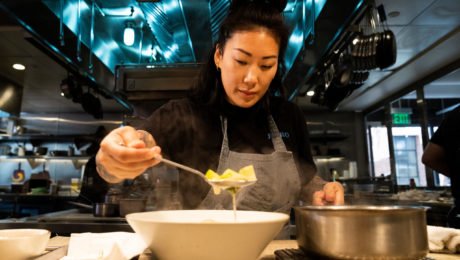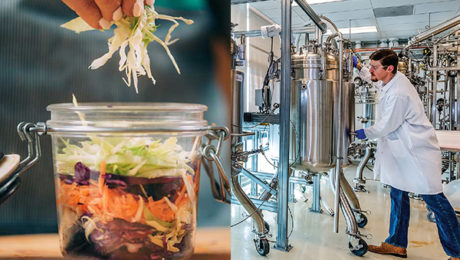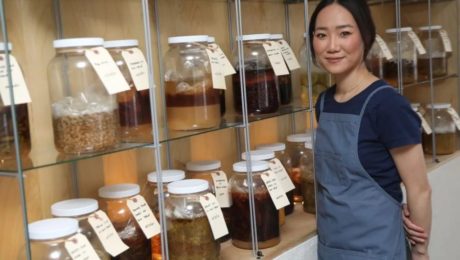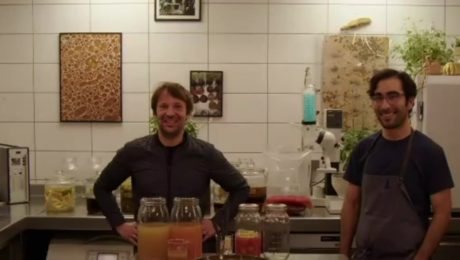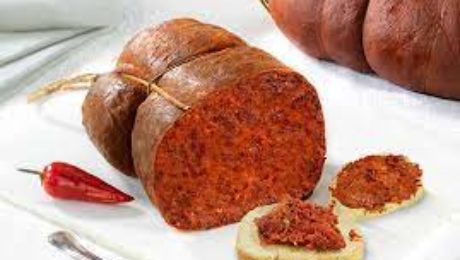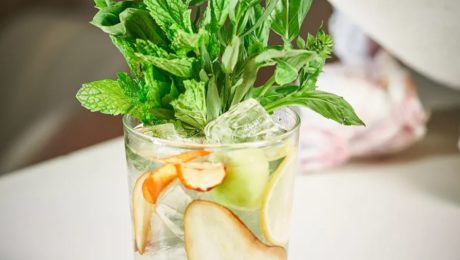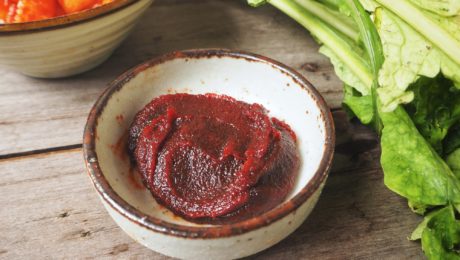Chicago: A Fermentation Hub
If you still think of hot dogs and deep dish pizza as the icons of Chicago’s culinary scene, you need to think again. The so-called Capital of the Midwest is a hub of innovation in the food industry. Chicago has the largest food and beverage production in the U.S., with an annual output of $9.4 billion. Food startup companies in the region raised $723 million in venture capital last year.
“Chicago is one of the most diverse cities for eating,” says Anna Desai, Chicago-based influencer of Would You Like Something to Eat on Instagram. ”Our culinary scene is constantly elevating and evolving. We are always just a neighborhood or tollway away from experiencing a new culture and cuisine. I’m most excited when I find an under-the-radar spot or discover a maker who can pair flavors and ingredients that get you curious and wanting more.”
Desai started her blog in part because she wanted to champion the Asian American and Pacific Islanders (AAPI) community in the Chicago food and beverage scene. “Food has long served as a cultural crossroad,” she adds, and Chicago’s multicultural cuisine exemplifies that sentiment.
Chicago is home to some of the most creative minds in fermentation, from celebrity chefs, zero waste ventures, alternative protein corporations and the world’s largest commercial kefir producer. There are dozens of regional and artisanal producers lacto-fermenting vegetables, brewing kombucha and experimenting with microbes in food and drink.
“Chicago is a great food city in its own right, so naturally there is a ton of talent in the fermentation space,” says Sam Smithson, chef and culinary director of CultureBox, a Chicago-based fermentation subscription box. “The pandemic’s effect on restaurants has also spawned a new wave of fermenters (ourselves included) that are looking for a path outside the grueling and uncertain restaurant structure to display our creative efforts. This new wave is undoubtedly community-motivated and concerned more with mutual aid than competition. There is a general feeling that we are all working towards the same goal so cooperation and collaboration is soaring and we are seeing incredible food come from that.”
Flavor is King
Flavor development is still the prime motivation for chefs to experiment with fermentation. A good example is at Heritage Restaurant and Caviar Bar in Chicago’s Humboldt Park neighborhood.
“Fermentation has been a cornerstone of the restaurant since its inception,” says Tiffany Meikle, co-owner of Heritage with her husband, Guy. “With the diverse cuisines we pull from, both from Eastern and Central Europe and East Asia, we researched fermentation methodologies and histories, and started to ‘connect the dots’ of each culture’s fermentation and pickling backgrounds.”
Menus have included sourdough dark Russian rye bread, toasted caraway sauerkraut, kimchi made from apples, Korean pears and beets and a kimchi using pickled ramps (wild onions). Heritage has also expanded their fermentation program to the bar, where they’ve created homemade kombucha, roasted pineapple tepache, sweet pickled fruits for cocktail garnishes, and kimchi-infused bloody mary mix.
“It’s fascinating to me that there are so many ingredients you can use in a fermented product,” says Claire Ridge, co-founder of Luna Bay Booch, a Chicago-based alcoholic kombucha producer. “People are really experimenting with interesting ingredients in kombucha…I have seen brewers do some of the wildest recipes and some recipes that are very basic.”
Innovating Food
Chicago-based Lifeway Kefir is indicative of the innovation taking place in the city. Last year the company expanded into a new space: oat-based fermentation, launching a dairy-free, cultured oat milk with live and active probiotics.
“We’ve spent so many years laying the groundwork in fermented dairy,” says Julie Smolyansky, CEO. “Now we’re experimenting and expanding to see what’s over the next horizon, though we’ll always have kefir as our first love.”
Chicago is home for two inventive fermented alternative protein startups: Nature’s Fynd and Hyfé Foods. Both companies were born out of the desire to create alt foods without damaging the environmental.
“Conscious consumerism is a trend that’s driving many people to try alternative proteins, and it’s not hard to understand why,” says Debbie Yaver, chief scientific officer at Nature’s Fynd. The company uses fermentation technology to grow Fy, a nutritional fungi protein. “Fungi as a source of protein offer a shortcut through the food chain because they don’t require the acres of land or water needed to support plant growth or animal grazing, making fungi-based protein more efficient to produce than other options.”
Alternative foods outlasting the typical trend cycle is a challenge for companies like Nature’s Fynd. When grown at scale, Fy uses 99% less land, 99% less water and emits 94% fewer greenhouse gasses than raising beef. But, to make an impact, “we need more than just vegans and vegetarians to make changes in their diets,” Yaver adds.
Waste Not
Numerous companies are using fermentation as a means to eliminate waste. Hyfé Foods, another player in the alternative protein space, repurposes sugar water from food production to create a low-carb, protein-rich flour. Fermentation turns a waste product into mycelium flour, mycelium being the root network – or hyphae (hence the company name) — of mushrooms.
“[We’re] diverting input to the landfill and reducing greenhouse gas emissions at scale,” says Michelle Ruiz, founder. “Hyfé operates at the intersection of climate and health, enabling regional production of low cost, alternative protein that reduces carbon emissions and is decoupled from agriculture.”
Symmetry Wood is another Chicago upcycler. They convert SCOBY from kombucha into a material, Pyrus, that resembles exotic wood. Founder Gabe Tavas says Pyrus has been used to produce guitar picks, jewelry and veneers. Symmetry uses the discarded SCOBY from local kombucha brand Kombuchade.
Many area restaurants and culinary brands also use fermentation to preserve food for the long Chicago winters, when local produce isn’t available. Pop-up restaurant Andare, for example, incorporates fermentation into classic Italian dishes.
“Finding ways to utilize what would otherwise be waste products inspired our initial dive into fermentation. The goal is not just to use what’s leftover, but to make it into something delicious and unique,” says Mo Scariano, Andare’s CEO. “One of our first dishes employing koji fermentation was a summer squash stuffed cappellacci served with a butter sauce made from carrot juice fermented with arborio rice koji. Living in a place with a short grow season, preservation through fermentation allowed us access throughout the year to ingredients we only have fresh for a few weeks during the summer.”
Industry Challenges
Despite growing interest and increasing sales, fermenters face some significant hurdles.
Smithson at CultureBox says he sees that consumers are open to unorthodox, less traditional ferments. Though favorites like kombucha and sauerkraut dominate the market, “their share is being encroached on by increasingly more varied and niche ferments.” But getting these products to market can be a challenge. Small-scale, culinary producers are challenged by the regulatory hoops they need to jump through to legally sell ferments – especially unusual ones a food inspector doesn’t recognize.
“The added layer of city regulations on top of state requirements, sluggish health department responses, and inflexible policy chill the potential of small producers,” Smithson says. But he highlights the recently-passed Home-to-Market Act of Illinois as positive legislation helping startup fermenters.
Consumer awareness and education are also vital. “Many longstanding and harmful misconceptions on the safety and value of fermented products still exist,” Smithson says.
Matt Lancor, founder and CEO of Kombuchade makes consumer education a core part of marketing, to align kombucha as a recovery drink.
“Most mainstream kombuchas are marketed towards the yoga/crystal/candle crowd, and I saw a major opportunity to create and market a product for the mainstream athletic community,” he says. “We’re on a mission to educate athletes and the general public about these newly discovered organs [the gut] – our second brain – and fuel the next generation of American athletes with thirst quenching, probiotic rich beverages.”
Product packaging provides much of a consumer’s education. Jack Joseph, founder and CEO of Komunity Kombucha, says simplicity is key.
“People are more conscious of their health now, more than ever before,” he says. “So now it comes down to the education of the product and creating something that is transparent and easy for the consumer to digest.”
Sebastian Vargo of Chicago-based Vargo Brother Ferments agrees.
“Oftentimes food is considered ‘safe’ due to lack of microbes and how sterile it is,” he says. “Fermentation eschews the traditional sense of what makes food ‘safe’. We need to create a set standardized guide for fermented food to follow, and change our view of living foods in general. One of the brightest spots to me is the fact that fermentation is really hitting its stride and finding its place in the modern world, and I don’t see it going anywhere but up in the near future.”
- Published in Business, Food & Flavor
“Koreanique” Food
As more Korean adoptees come of age to run restaurants, a new dining style is emerging: “Koreanique” (or Korean-style, Korean-inspired or “kinda Korean”).
“For these chefs, cooking is the ultimate reclamation of their Koreanness — and an act that pushes the cuisine to exciting places,” reads an article in The New York Times.
They produce dishes that “reflect their American upbringings and Korean heritage” of the adoptee chefs. Examples are: Jewish matzo ball soup with Korean mirepoix, Spam musubi burritos, kimchi-enriched carbonara, chicken marinated in kimchi brine, battered fish-sauce-laden zucchini with a sweet soy dipping sauce, jajangmyeon sauce with Bolognese and gochujang barbecue sauce.
Still, they note, feelings of imposter syndrome and cultural appropriation can take over. Adoptee chefs tell The Times they worry they’re not making Korean food authentically and they struggle with their complicated relationships with Korean food when they grew up eating a different culture’s food.
Read more (The New York Times)
- Published in Food & Flavor
Will Fermentation Connect Gastronomy and Biotech?
Fermentation is motivating scientists to listen to gastronomers, a rare occurrence in the field of science.
“There’s going to be a huge exchange in this two-way road that we’re living in. Innovation in flavor coming from gastronomy and innovation coming from a high-level biotechnology, they are going to be harmonious,” says Jason White, director of the fermentation lab at Noma in Copenhagen. “We’re going to be able to create this infrastructure and community of people who have the same goal, and the same goal is going to be the wellness of our planet.”
White spoke at the 2nd international Food Innovation Conference. This annual gathering of industry experts is produced by the Gottlieb Duttweiler Institute (GDI), Switzerland’s oldest independent think tank, which researches the future of food, retail and health.
The conference focused on the future of fermented alternative proteins. Or, as GDI puts it: “how innovation can solve the carnivore conundrum.” Speakers included the founders of numerous precision fermentation companies, such as SuperBrewed Food, Bosque Foods, Melt&Marble and WNWN Food Labs.
“We do the same thing, we just have different outputs”
Fermentation for alternative proteins is a divisive topic among traditional fermenters. Many say it’s lab-created fake food. Advocates, though, argue precision fermentation using DNA from mammals (as with Impossible Foods’ heme protein burger) and biomass fermentation of fast-growing, naturally-occurring organisms(e.g., Nature’s Fynd fungi protein) are reducing the risk of a global food crisis. Meat consumption is increasing, but animal meat is environmentally inefficient to raise. The significant amounts of agricultural land, fertilizer, pesticide and hormones needed to raise animals for meat protein release harmful carbon emissions.
The chefs on GDI’s “Fermentation: A World Within Gastronomy” panel spoke favorably of using fermentation for alt foods. White was joined by Ezio Bertorelli, co-founder of fermentation shop Meta Copenhagen, and Sirkka Hammer, founder of food manufacturer Wiener Miso in Austria.
“I think that it’s important for us not to steer too far away from the origins of fermentation,” White notes. But, “whether you have this bioreactor filled with whatever working inside of a laboratory with a team of scientists, we are still creating something that comes from microorganisms and from organisms. And so we do the same thing, we just have different outputs, different audiences.”
Precision fermentation technology is rooted in traditional fermentation, he notes. You need to understand the abilities of microbes and composition of ingredients for a successful precision fermentation.
“Inside of these laboratories and restaurants, there’s so many things that are being discovered that stop at the guest experience,” White says of fermentation. Today, as fermentation continues a revitalization as a kitchen craft, it’s utilized by more people rather than just chefs and scientists.
DIscovering Fermentation
Hammer highlighted the boom in home fermentation, with people creating the bold flavors of fermented foods and beverages on their own countertops.
“There’s a certain magic in fermentation. That’s why you’re gripped with it,” she says. “People are bringing a little bit of that magic, uncontrollable magic maybe [into their homes].”
At Wiener Miso, Hammer launched the company’s umami-driven ferments after living in Asia for more than a decade. The spices, pastes and sauces she makes are based on traditional Japanese ferments.
“Fermenting gives you in gastronomy next level or an add-on of flavors and textures,” she says. “Fermentation really changes the texture in a different way than if you cook it or freeze it. It gives it new dimensions.”
Flavor is what introduced Bertorelli to fermentation, too. His background is in professional cooking – he is the former executive chef of La Petite Table in Paris – but he was always experimenting with miso and sauerkraut in his home kitchen.
Even today, his fermentation experiments “go terribly wrong most of the time,” says Bertorelli. Only about 5% are successes, “that’s what makes it exciting.”
“Fermentation really changed my life because it showed me most of the dishes I was passionate about, the origin of the flavor, was the fermented part,” he says. “Flavor is universal… If you have that mind-blowing moment, it can reconnect you with things that are inside all of us, like our ancestors have been eating these foods since thousands of years ago and it’s sort of like going back in time while still being here.”
- Published in Food & Flavor
Chef’s Secret: Fermented Bean Curd
Chef Andrew Wong created the first Michelin two-star Chinese restaurant outside Asia. His London-based A Wong is an homage to China’s 3,000-year culinary history and a contemporary spin on the country’s regional cuisine.
Fermented wild sea bass and fermented coconut are part of the “Taste of China” dinner menu. A popular dish called “Why the Buddha Didn’t Jump Over the Wall” is barbecued sweet potato covered in a fermented, salted black-bean relish. It’s no surprise Wong’s favorite ingredient is fermented bean curd. He says the tofu, soaked in salt and chili, is as close to cheese as you can get in China. It’s eaten with congee and used as a condiment.
“It’s very salty; umami in its purest form,” Wong says. “I use it a lot in my cooking, especially in vegetarian dishes where we can’t use oyster sauce. We cook it out with some stock, ginger, garlic, and make a sauce. The combination of vegetables, garlic, chili and fermented bean curd creates a really deep meaty flavor.”
He advises chefs to use it like a stock cube, because it’s soft and will coat the mouth in umami flavor.
Read more (Guardian)
- Published in Food & Flavor
Canada’s Culinary Trailblazer
Briana Kim is making a name for herself in the Canadian food scene, “putting Ottawa on the map with a focus on fermentation,” writes the Ottawa Citizen. Kim, a self-taught, award-winning chef, runs Alice, a vegan restaurant in Ottawa’s Little Italy neighborhood. Her specialty is fermentation-applied, plant-based cooking. Last fall, she was invited to Eleven Madison Park in New York to share her insight with the chefs as they transitioned to a vegetarian-oriented restaurant.
Continues the article: “It’s definitely a rarefied subject. But in the world’s top-tier kitchens, fermenting food is a red-hot trend, with plant-based cooking not far behind. At Alice, Kim’s imaginative creations such as charcoal-grilled dried maitake mushrooms and sunchokes served with a salsa of tomato and fermented green strawberries, and a sweet pea miso dipping sauce make clear that Alice’s name’s alludes to a surprising culinary wonderland.”
Alice, which opened in 2019, operates with a culinary and scientific focus.
“The innovation and the R&D have to be the No. 1 focus for us,” Kim says. “Fermentation allows us to discover how different food molecules break down and change in texture and flavors, and we are always searching for flavors we haven’t tasted before.”
The waiting room at Alice is filled with jars of Kim’s different ferments, many of which she sells under her Mad Ferments label. She utilizes locally-grown ingredients, planning the menu at Alice months in advance.. For example, she serves cauliflower, spring greens and melons in the middle of winter by fermenting them in the summer.
“Fermentation has existed for such a long time, but I think we are putting our twist on it,” Kim says.
Read more (Ottawa Citizen)
- Published in Food & Flavor
Redzepi: “Fermenting is our future”
An interesting indication of how quickly and decisively fermentation is moving into the U.S. food mainstream is a recent online event organized and offered by American Express and restaurant booking service Resy, “A Fermentation Workshop with Noma.” For $50, one could sign up for an hour-long Zoom — introductions from Noma’s René Redzepi and Jason White, and demonstrations of making lacto-fermented tomatoes and a juice-based kombucha, all moderated by renowned food writer Ruth Reichl — and a copy of 2018’s “The Noma Guide to Fermentation.” The event sold out in minutes.
Redzepi (Noma chef and co-owner) and White (Noma’s head of fermentation) were in their fermentation lab at the restaurant, and gave concise, compelling comments on the long history of fermentation and its importance. They noted the healthful aspects of the process but emphasized its ability to produce delicious flavors.
“One of the most important things for me as a fermenter is definitely having a closer look at nature, and also being able to create new and interesting flavors that can have beneficial effects on humans, meaning it can make us healthier, it can make our dinners more exciting and also we can teach future generations how they can interact with nature as well,” White says. “The power of fermentation is a really good bridge to that because, in one way or another, in every culture, in every place on earth, there are people who have been doing it for thousands of years. I think it’s important for us to carry the torch. And I think carrying the torch of fermentation is definitely my biggest dream, to carry it for another thousand years.”
When Noma opened over 18 years ago, it was in the dead of winter and they struggled to deliver meals made from Nordic ingredients. “We were really desperate to find food,” Redzepi continues. By spring, they began foraging, “it grounded us and gave us direction.” A few years into foraging, they wondered how they could take the abundance of spring and summer ingredients and use it in the long winter season.
“That’s when we started dabbling into fermentation,” he says. “And from that moment on, a whole new world opened up for restaurant Noma. You could even say fermentation eclipsed foraging because we found out, through the yeast and the mold and the bacterias, we could simply create such new flavors that would transform our kitchens forever. We started tapping into the community worldwide of fermenters and traditional fermentations, adapting them to our ingredients and our region and thus creating a new set of tools that has really engrained itself into every single Noma dish. You don’t eat anything at Noma that doesn’t have ferments in them.”
“Instead of food waste, you can ferment it into something delicious,” he adds.
They made the recipes seem easy to execute (though I suspect the presentation of SCOBY might have put off some participants). And, to ensure at least a small dose of titillation, they proffered a container of one current project in the lab, “Reindeer Penis Garum.” They used this as an example of how fermentation can minimize waste by finding applications for what would otherwise be scrap or trash.
The detailed discussion of kombucha was illuminating, including an interesting contrast with vinegars. Noma makes numerous kombuchas, both for direct consumption and for use as an ingredient. Redzepi expressed his personal perspective, which helps explain why. He says he has yet to find a commercial product “that’s worth buying” — and it’s easy to make yourself.
It was great to see fermentation as a front-and-center topic, but there is still work to be done. The literature that was sent to all participants to accompany the presentation included references in the kombucha recipe to “backstop” and “backdrop” liquid — though they meant “backslop.”
- Published in Business, Food & Flavor
“Poor Man’s Viagra”
More chefs are experimenting with ‘nduja, a spreadable, fermented pork salami. ‘Nduja is packed with Calabrian chiles, giving it a kick with an underlying sweetness.
‘Nduja hails from northern Italy, dating back to either the 13th Century or early 1800s (historians dispute the date). Food experts agree ‘nduja was inspired by the French sausage andouille, typically made from pork and pig innards. Like many other fermented dishes, it’s believed to have been “born out of necessity…the cured pork product that’s resistant to spoilage was originally made using excess fat and meat trimmings left over from the butchering process.” Once all ‘nduja’s ingredients are minced together, the meat is stuffed into sausage casings, fermented for 2-5 days and then aged.
‘Nduja (pronounced en-doo-ya) is referred to as “red Nutella” and the “poor man’s Viagra” (the latter because of the belief that chilli peppers are a natural stimulant).
Read more (SBS Australia)
- Published in Food & Flavor
Reviving a Fermented Soda
Is gazoz — a Mediterranean-born mocktail made with fermented fruit and herbs — the next trending drink? It“fell out of favor for a few decades,” according to an Eater article, but chefs and bartenders in Turkey and Israel are bringing it back.
Gazoz is a flavor-packed drink that is also visually striking. It’s served packed with herbs and chunks of fruit. Chef Benny Briga (Cafe Levinsky 41 in Tel Aviv) and author Adeena Sussman have written a new book on the drink.They include numerous variations on the drink, including ones that highlights Briga’s signature seasonal fruit syrup that he says is made by “sweet fermentation.” Many of the drink recipes in “Gazoz” also include sweet-fermented spices, nut syrups and aerobic fermentations such as kefir and kombucha.
Read more (Eater)
- Published in Food & Flavor
The Gochujang Debate
The next “it” condiment in the U.S, gochujang is sweet and spicy, fermented for six to 12 months, and adding an umami tang. More restaurants are incorporating gochujang into their dishes, like the Shake Shack chain has done with their new Korean-Style Fried Chick’n sandwich.
But gochujang’s popularity has been a divisive issue. On one hand, many critics say mainstream food culture shouldn’t cherry-pick trends. “Ethnic foods, particularly the fermented variety, have a history of being typecast as unappetizing in the United States,” writes Hanna Park, the article author. She quotes Eric Kim, a food writer for The New York Times who says he hates that gochujang is now popular: “I never like to say a pantry ingredient is ‘trending’ or ‘mainstream,’ because that implies it is new. But new to whom? Gochujang is one of the oldest foodstuffs, beloved by millions of people for centuries.”
Meanwhile, other food experts say it’s wonderful to see Korean food used as inspiration for new dishes. Chef Hooni Kim, who owns Danji and Hanjan restaurants in New York City, says there was a time when Americans didn’t know anything about Korea, confusing it with China and Japan. Gochujang helps people appreciate Korea for its food culture. “It all comes down to execution. If they make it delicious, so people like Korean fried chicken or gochujang, then I thank them,” he said.
Read more (NBC News)
- Published in Food & Flavor
The Dodo of Gastronomic History
Scientists are working to recreate an ancient garum, considered the “dodo of gastronomic history.” Beloved by Mediterranean civilizations, the fish sauce was thought by historians to be extinct, lost along with the Roman Empire.
Food technicians got new insight into this garum when archaeologists discovered sealed dolia (large clay storage vessels) at what is believed to be a former Garum Shop at Pompeii. The eruption of Mount Vesuvius buried the building, preserving the factory. The charred, powdered remains left in the vessels — plus a fish sauce recipe believed to have been from the 3rd century A.D. — has aided food techs in recreating the ancient garum.
This product uses heavily salted small fish fermented for one week with dill, coriander, fennel and other dried herbs in a closed vessel. The resulting “Flor de Garum” is sold in Spain by the Matiz brand in amphora-shaped glass bottles.
Top chefs in Spain have been using Flor de Garum in new dishes. Mario Jiménez Córdoba, chef at El Faro in Cádiz, uses it in black-truffle ice cream, a raw sea bass dish and chocolate ganache.
“When people think of garum,” Jiménez says, “they imagine something that smells disgusting. But we have to think of garum like we would salt, or soy sauce. You use only a few drops, and the flavor is incredible.”
Read more (Smithsonian Magazine)
- Published in Food & Flavor, Science


